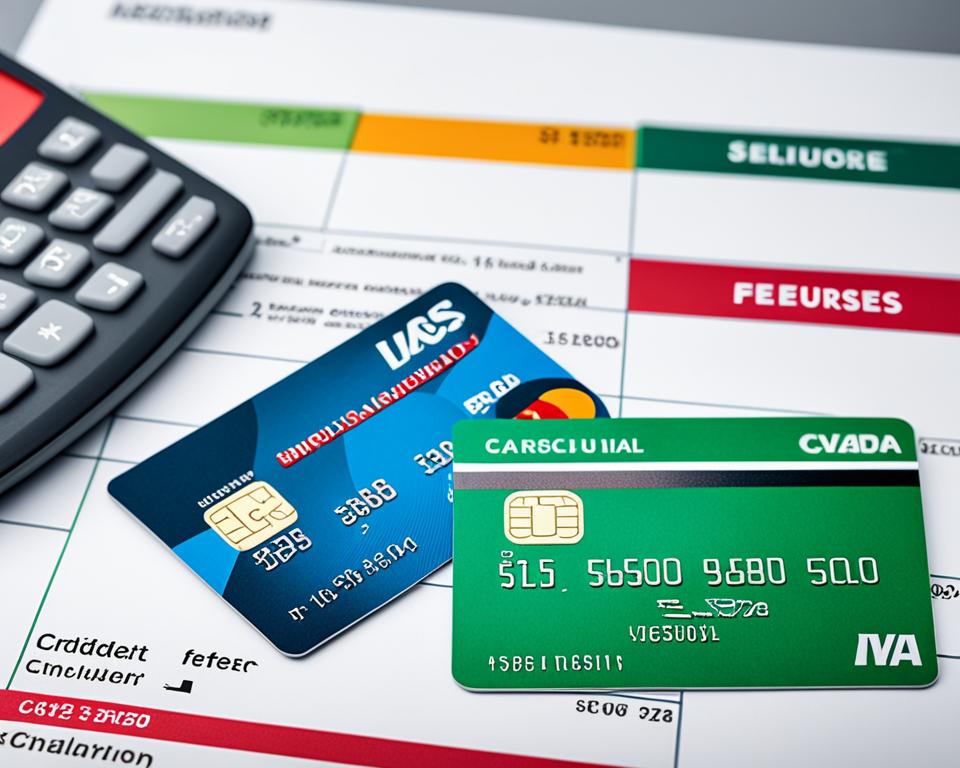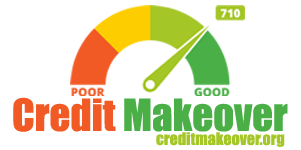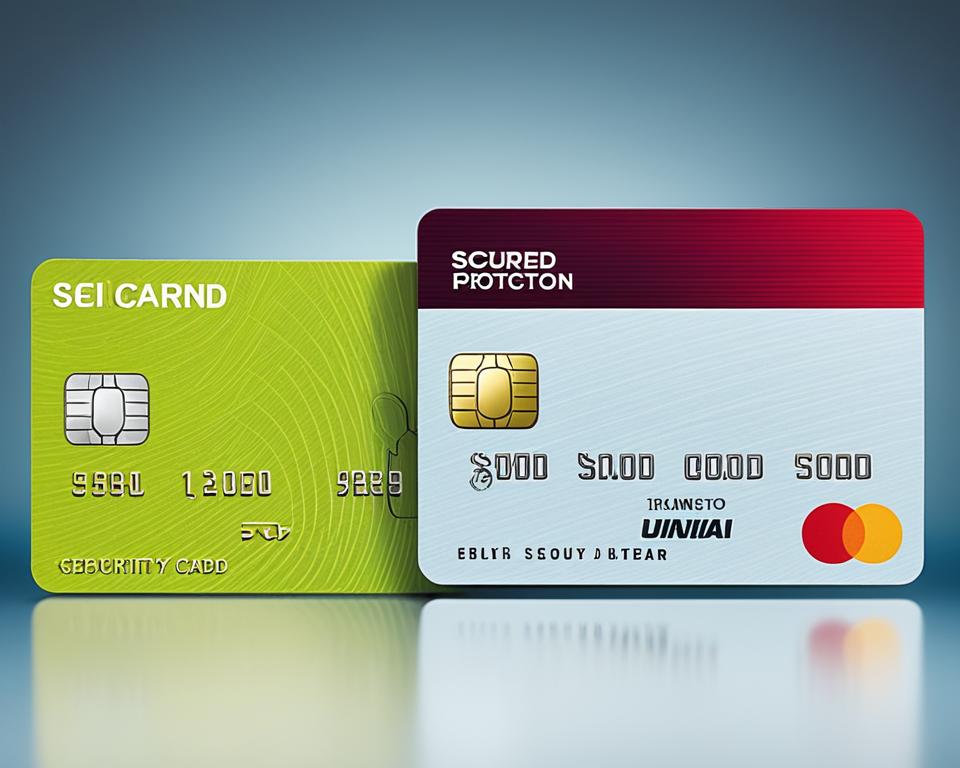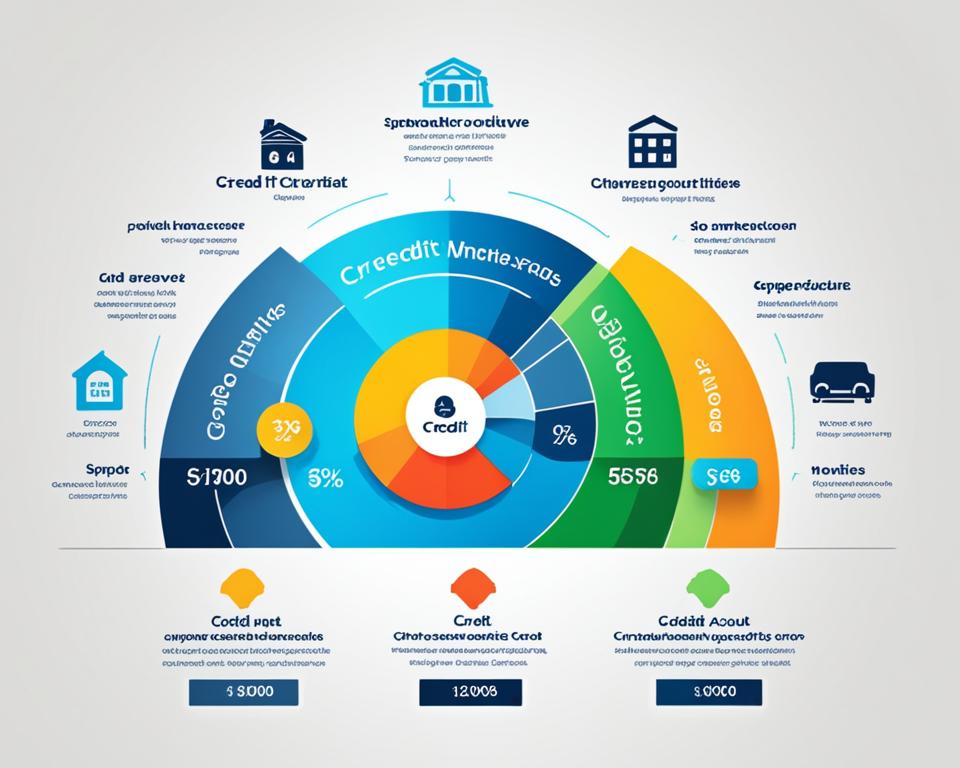Embarking on the financial journey of credit building requires making informed financial decisions, particularly when it comes to selecting a credit card. The decision between secured vs. unsecured credit cards can be pivotal for individuals in various stages of their financial paths. Secured credit cards demand a cash deposit upfront, serving as a collateral and providing a credit line typically equivalent to the deposit amount. This makes them a viable option for those with limited credit history or less-than-ideal credit scores, striving to establish a solid credit foundation. On the other hand, unsecured credit cards, the customary choice of many, do not necessitate such deposits and are often attainable by individuals with higher credit ratings. They frequently come bundled with attractive rewards and lower interest rates, yet require more stringent qualifications from applicants.
Underpinning these card differences is a shared goal: to enable users to showcase fiscal responsibility and accumulate a credit history that paves the way for future financial opportunities. Whether through a secured credit card where disciplined use reflects positively on credit reports or through the judicious management of an unsecured card’s freedom, these instruments are more than mere spending tools. They are stepping stones towards greater economic stability and freedom.
Key Takeaways
- Secured credit cards are tailored for credit building, especially for those with poor or no credit history.
- Unsecured credit cards are more common and do not require a security deposit, offering better interest rates and rewards.
- A security deposit is central to secured credit cards, introducing a recoverable safeguard for lenders and a credit line for consumers.
- Navigating the differences between secured and unsecured credit cards is key to making savvy financial decisions.
- Ultimately, both card types can contribute to establishing a strong credit history when managed responsibly.
Exploring Credit Card Basics
Embarking on a credit card journey involves more than just picking a card; it requires a comprehensive understanding of how these financial tools function within the broader credit card industry. Credit cards are not just a means of transaction but pivotal instruments in shaping one’s financial health and access to monetary flexibility.
What is a Credit Card?
A credit card is a plastic or digital tool issued by a financial institution that allows cardholders to borrow funds within a pre-approved limit for purchasing goods and services. As part of the credit card industry, these cards present a revolving line of credit, meaning users can repeatedly borrow and repay up to their credit limit as long as the account remains open and in good standing.
The Role of Credit in Personal Finance
Credit influences various stages in an individual’s financial life, from securing a mortgage or car loan to determining interest rates one qualifies for. Building a positive credit history with timely payments and responsible use can open doors to more attractive loan terms, lower insurance premiums, and even influence job prospects. Thus, credit plays a crucial role in a person’s personal finance landscape.
Understanding Credit Card Terms and Conditions
To navigate the credit card journey successfully, it’s essential to comprehend the terms and conditions associated with different cards. Factors such as rewards programs, welcome offers, annual percentage rate (APR), and customer experience influence the decision-making process. By providing reliable market information, trusted resources like Bankrate enable consumers to parse through complex offers and make intelligent, informed choices.
| Term | Definition | Consumer Impact |
|---|---|---|
| APR | Annual Percentage Rate reflects the cost of borrowing on the card yearly, including interest and fees. | Lower APRs can result in less paid over time when balances are carried from month to month. |
| Credit Limit | The maximum amount a cardholder can borrow on a credit card. | A higher credit limit can improve credit utilization ratios, potentially boosting credit scores. |
| Rewards Program | Perks offered by card issuers, such as cash back, points, or miles, for purchases made with the credit card. | Rewards can provide significant value back on everyday spending when used strategically. |
| Welcome Offer | A bonus, often points, miles or cashback, given when a new cardholder meets initial spending requirements. | Offers can provide a quick boost to rewards balances, often offsetting any potential fees. |
Defining Secured Credit Cards
Embarking on the path to credit improvement, individuals often encounter secured credit card requirements as a threshold to entry. Secured credit cards serve as an essential financial tool, offering a stable platform for those with lesser credit to establish themselves. Retaining their place in the pantheon of fiscal remediation, secured credit cards represent not only a line of credit but also a beacon of hope for improved financial future.
How Secured Credit Cards Work
Secured credit cards exude practicality for individuals in need of credit redemption or establishment. These cards operate on a fundamental principle: a cash deposit placed by the cardholder acts as collateral. In effect, the credit limit of the secured card often mirrors the deposit amount, instilling a sense of protected lending on the part of the creditor and a platform for the cardholder to demonstrate financial responsibility.

The Purpose Behind the Security Deposit
The security deposit stands central in the secured credit card ecosystem. It acts as a safety net, securing the line of credit and alleviating risks for lenders. This deposit is not just a safeguard but establishes the credit limit, which can be pivotal for secured credit card benefits such as credit building and the potential to graduate to unsecured credit cards as one’s creditworthiness escalates.
Common Features of Secured Credit Cards
As a vessel for financial reparation, secured credit cards often carry features designed to guide users towards better credit habits. While higher APRs may be a commonality in light of the risks assumed by issuers, these cards also offer a crucial advantage—their activity is reported to major credit bureaus, facilitating the growth of one’s credit score with consistent and timely payments. Moreover, various issuers may endow their products with the potential to earn rewards, effectively merging remediation with remuneration.
| Feature | Description | Benefit |
|---|---|---|
| Security Deposit | A cash collateral that determines the credit limit. | Enables credit access for individuals with lower credit scores. |
| Credit Reporting | Regular reporting of card usage to credit bureaus. | Aids in building or rebuilding credit history over time. |
| APRs and Fees | Costs associated with borrowing on the card. | Helps to gauge the full cost of using the credit card. |
| Rewards Programs | Opportunities to earn cash back or points. | Provides additional incentive for card use and timely payments. |
Overview of Unsecured Credit Cards
Unsecured credit cards are quintessential to contemporary financing, acting as a cornerstone for everyday transactions and money management. Recognized widely for their unsecured credit card advantages, such as no required security deposit, they open a realm of possibilities to consumers with established credit histories. These cards are naturally alluring due to the myriad of benefits they furnish.
Accessibility to unsecured credit cards primarily hinges on the unsecured credit card approval process, which typically involves evaluating one’s credit score. Prospective cardholders with good to excellent credit are the primary candidates, with financial institutions associating these credit ratings as indicators of reliability and low risk.
Unlike their secured counterparts, unsecured credit cards do not necessitate an upfront cash deposit, thus eliminating a barrier and accelerating the pathway to credit. They often entice customers with lower interest rates, which is a significant financial motivator, saving cardholders from accruing high levels of interest over prolonged periods.
Moving beyond the functional aspect of borrowing, unsecured credit cards dazzle with diverse reward programs. These can range from cash back on everyday purchases to travel miles and bonuses on specific categories, maximizing return on spending. These incentives not only sweeten the deal but also encourage judicious financial behavior through strategic usage.
| Feature | Advantages |
|---|---|
| No Deposit | Eases initial financial burden and streamlines access |
| Lower Interest Rates | Reduces the overall cost of borrowing and can lead to substantial savings over time |
| Rewards and Bonuses | Provides opportunities to earn various types of rewards, enhancing the value of purchases |
| Credit Building Potential | Responsible usage is reported to credit bureaus, possibly improving credit score |
Therefore, for those who meet the criteria, unsecured credit cards represent not just a utilitarian transactional tool but also a strategic asset that, when managed astutely, can enhance one’s financial wellbeing.
Secured vs. Unsecured Credit Cards
When choosing a credit card, understanding the secured vs unsecured card differences is essential for making an informed decision tailored to your financial needs. The critical disparity lies in the deposit and credit requirements, affecting the terms and benefits associated with each card type. Exploring these aspects provides clarity on which card may serve you best.

The Deposit Dilemma: Comparing Collateral Requirements
One of the most distinguishing features between secured and unsecured credit cards is the necessity for a deposit. Secured credit cards demand a refundable security deposit, which forms the basis of the credit limit. This deposit acts as collateral, minimizing the risk for lenders while offering a credit-building platform for consumers. In stark contrast, unsecured credit cards require no such collateral, offering a more straightforward line of credit based on the cardholder’s creditworthiness.
Assessing the Credit Score and Approval Process
The approval process for unsecured credit cards is known for being stringent, with high credit scores and verified income as standard qualifiers. These requirements reflect the credit issuer’s need to assess risk and grant credit to individuals with a proven track record of financial reliability. On the flip side, secured credit cards typically welcome consumers with lower credit scores or no credit history, providing a viable path to improve and build creditworthiness over time.
Financial Impact: Interest Rates and Fees
The financial implications of using a secured or unsecured credit card are profound, with interest rates and fees taking the spotlight. Typically, secured credit cards carry higher APRs compared to the often more favorable terms of unsecured cards. This reflects the risk profile of the cardholder base. On the cost side, while secured cards necessitate a deposit, they may not entail other fees, whereas unsecured cards might waive the deposit but come with other fees or higher APRs.
| Card Type | Deposit Required | Credit Score Requirement | APR |
|---|---|---|---|
| Secured Credit Card | Yes | Lower or None | Generally Higher |
| Unsecured Credit Card | No | Higher | Generally Lower |
Understanding these secured vs unsecured card differences can greatly affect your credit journey and long-term financial success. Choose wisely considering your current credit standing and future financial goals.
Understanding the Credit Building Process
Embarking on the journey of credit building is a strategic endeavor that requires patience, discipline, and a keen understanding of financial habits. Whether opting for a secured or unsecured credit card, certain practices within the credit building process hold the key to eventual financial empowerment and credibility. Attention to detail in managing credit can lay a firm foundation for future fiscal opportunities.
The Importance of On-Time Payments
At the heart of the credit building process is the fundamental habit of making on-time payments. Consistency in this area is not only about avoiding late fees but also profoundly influences one’s credit score. Financial institutions report payment behavior to credit bureaus, allowing these timely payments to serve as a testament to the cardholder’s reliability and trustworthiness.
Credit Utilization and Its Effect on Your Score
Credit utilization — the ratio of your credit card balance to your credit limit — plays a critical role in credit scoring models. Experts recommend keeping this ratio below 30 percent, as it signifies to lenders that you are managing credit prudently and not overextending your financial commitments. This practice helps maintain a healthy credit profile, which is vital in the credit building process.
How Long Does It Take to Build Credit?
While the timeline to construct a robust credit history varies per individual, the essence of building credit lies in maintaining consistent, responsible credit behavior over time. Positive results can emerge within months of diligent financial activity, but establishing a strong credit score typically unfolds over years. Patience combined with strategic financial planning progressively fortifies one’s credit standing.
- Ensure timely monthly credit card payments
- Aim to maintain credit utilization below 30 percent
- Regularly monitor credit score changes and report discrepancies
- Understand that credit building is a long-term commitment
| Credit Building Action | Immediate Benefit | Long-Term Effect on Credit Score |
|---|---|---|
| On-Time Payments | Avoiding late fees | Enhancing payment history |
| Low Credit Utilization | Reduction in debt levels | Positively adjusting credit utilization ratio |
| Longevity of Credit Accounts | Establishing credit history | Increasing credit score through a sustained history |
| Diverse Credit Types | Expanding credit mix | Improving risk assessment by showcasing varied credit handling |
Eligibility Criteria for Secured and Unsecured Cards
When you’re in the market for a credit card, understanding the eligibility criteria for both secured credit card options and unsecured credit card options is fundamental. These criteria will not only influence what type of card you qualify for but also determine your capability to manage it effectively.
For many, secured credit cards represent a point of entry into the world of credit. They require a refundable security deposit, which acts as collateral and determines your credit limit. This deposit effectively reduces the risk for the issuer, making secured cards particularly accessible to those with poor credit or no credit history at all. Consequently, the income requirements for secured cards may be more accommodating, opening up a path to credit for a wider range of consumers.
In contrast, unsecured credit cards cater to individuals who have already established a certain level of creditworthiness. These cards do not require a security deposit, but they do often demand higher credit scores and verified income. Therefore, they tend to be more suitable for applicants who can demonstrate a stable financial history.
Eligibility for unsecured credit cards is generally based on financial reliability and existing credit history, setting a higher bar for approval when compared to secured cards.
Below, a table compares the key eligibility criteria for both secured and unsecured credit cards:
| Criteria | Secured Credit Card | Unsecured Credit Card |
|---|---|---|
| Security Deposit | Required | Not Required |
| Credit Score | Lower or None | Higher |
| Income Requirement | More Flexible | Higher, More Stringent |
| Approval Odds | Good for Building Credit | Dependent on Creditworthiness |
Whether you are just starting out and leaning towards secured credit card options, or you’re more established and considering unsecured credit card options, it’s important to assess where you stand against these criteria. This due diligence will support you in finding a credit card aligned with your current financial situation, while also setting you up for success in managing credit responsibly.

The Road to Approval: Applying for Credit Cards
The credit card application process marks a significant step in securing financial leeway and building a credit history. Whether applying for a secured or unsecured credit card, applicants need to furnish a variety of personal details. The documentation involved is essential for credit card companies to perform necessary credit checks and establish trustworthiness.
Documentation and Information Required
Beginning the credit card application necessitates compiling several pieces of critical information. These are the keystones that help financial institutions to comprehend an applicant’s fiscal background. Required details often encompass the applicant’s full name, date of birth, residential address, Social Security number, and employment status, including the employer’s name and contact information. Additionally, a clear disclosure of income is required to evaluate the potential cardholder’s ability to manage credit.
Navigating the Application Process
The journey through the credit card application is marked by careful reviews and assessments by the issuer. For secured cards, part of the application involves submitting the security deposit. This amount acts as collateral and often equates to the credit limit offered. Notably, should the application not result in an approval, this deposit is promptly refunded. Conversely, when eyeing unsecured cards, there isn’t a need for such a deposit, although the application still scrutinizes similar personal and financial details.
It’s crucial for applicants to check and prepare all the required information beforehand, ensuring a smooth and efficient application experience. Secure handling of the personal data during this process is of the utmost importance, as it facilitates a transparent and secure exchange.
Here is a summary table of what to expect during the application process:
| Card Type | Required Information | Security Deposit | Refund of Deposit |
|---|---|---|---|
| Secured Credit Card | Full legal name, DOB, address, SSN, employment and income details | Yes, paid during application | If application is declined |
| Unsecured Credit Card | Full legal name, DOB, address, SSN, employment and income details | No deposit required | Not applicable |
Understanding the intricacies of the credit card application process can demystify the steps involved, empowering potential cardholders to approach this milestone with confidence and clarity.
Transitioning from Secured to Unsecured Cards
For many financially savvy individuals, the moment arrives when upgrading from secured to unsecured credit cards becomes an integral step in their credit journey. The path from a secured to an unsecured credit card is a rite of passage that reflects improved credit health and opens the door to greater financial products and benefits. Recognizing the appropriate time to make this move and understanding the process involved is key to advancing one’s credit status seamlessly.
When to Consider Making the Switch
Moving from a secured to an unsecured credit card is a decision that should coincide with achieving a healthier credit score, often the result of meticulously handling a secured card. It’s advisable to review your credit score regularly; once it starts approaching the “good” range, usually around a FICO score of 670 or higher, it may be time to consider this upgrade. The transformation from a secured card holder to becoming an eligible unsecured card user signifies a milestone in financial responsibility and creditworthiness.
The Process of Upgrading Your Credit Card
The process of upgrading typically involves two main avenues: either transitioning your existing secured credit line to an unsecured one upon request to the issuer, or by applying for a new, separate unsecured credit card. Upon successful upgrading or account closure of the secured card with a zero balance, the initial security deposit is returned, marking the conclusion of a secure card’s utility and the beginning of the journey with standard credit cards.
It is important to note that strategies for upgrading may vary amongst financial institutions. Some issuers may automatically review your account after a certain period of commendable use, offering to return your deposit and convert your card. Others require an explicit request or submission of an application for an unsecured card. Prior to initiating any changes, a thorough review of one’s finances and credit standing is prudent, ensuring readiness for the new fiscal responsibilities that accompany unsecured credit cards.
| Action | Consideration | Impact |
|---|---|---|
| Check Credit Score | Ensure it’s in the ‘good’ range or higher | Determines eligibility for unsecured cards |
| Request Card Conversion | Ask issuer to upgrade existing card | May retain account history and length |
| Apply for New Card | Seek additional unsecured credit cards | Potentially diversify credit sources |
| Deposit Refund | Closure of secured account in good standing | Security funds returned, completing the secured card cycle |
In summary, the responsible management of secured credit cards often leads cardholders to the juncture of upgrading to unsecured credit cards. Thorough understanding and strategic planning are paramount for a smooth transition, heralding a new chapter in personal financial management and credit sophistication.
Secured vs. Unsecured Card Differences in Terms of Rewards
To make savvy financial decisions, one must consider the rewards and benefits offered by different credit cards. Notably, the gap between secured vs. unsecured card rewards can be quite substantial. While both card types play pivotal roles in credit building and transactions, their reward programs differ significantly, affecting the overall value and potential savings for the cardholder.
Exploring Reward Structures and Perks
Secured credit cards, designed chiefly for rebuilding or establishing credit, surprisingly offer some opportunities for rewards. Although the credit card rewards available on secured cards may not be as varied or lucrative as those found on unsecured cards, the presence of such perks provides an additional incentive to maintain good credit habits. For instance, select secured cards might offer cash back on certain categories of purchases, albeit at lower rates than those offered on unsecured cards.
Maximizing Your Card’s Potential
Fostering a deep understanding of your credit card’s reward program is instrumental in maximizing credit card benefits. This involves not only scrutinizing the rewards themselves but also recognizing how your spending patterns align with the reward opportunities. For unsecured credit cards, rewards can significantly add to the card’s appeal, often featuring diverse programs that may offer cash back, points, or miles on various purchase categories. Using these cards strategically—targeting high-reward categories and taking advantage of bonus offers—can transform everyday spending into a wealth of benefits.
As you immerse yourself into the intricacies of your cards’ rewards programs, whether secured or unsecured, remember that consistent spending discipline paired with an astute redemption strategy sets the stage for a bounty of credit card rewards.
Examining Interest Rates and Annual Fees
When embarking on the quest for a new credit card, interest rates and annual fees stand out as critical factors to consider. For the savvy consumer, these elements are just as vital as the credit limit or rewards programs when determining the overall affordability and value of a card. In the realm of credit cards, the landscape of interest rates and fees can greatly influence one’s financial outcomes.
Secured credit cards often cater to those with less-than-stellar credit or those looking to build credit. However, in compensating for the heightened risk assumed by lenders, these cards typically feature higher interest rates. Consumers may also encounter additional costs bundled with the security deposit, which further emphasizes the need for mindful financial planning.

Opposingly, unsecured credit cards, which are usually available to individuals with good to excellent credit, offer the allure of lower interest rates, potentially translating to hundreds of dollars in savings on purchases that carry over a monthly balance. While many unsecured cards do charge annual fees, particularly those with a rich array of rewards and benefits, they are not a universal feature and can often be avoided altogether.
Thus, when selecting between these two pivotal credit card types, it is essential to conduct a comparative analysis of their respective interest rates and annual fees. Doing so requires due diligence and a consideration of the long-term financial implications that each card’s terms present.
| Credit Card Type | Interest Rate Considerations | Annual Fees |
|---|---|---|
| Secured Credit Cards | Generally come with higher interest rates due to the risk profile of the cardholder | May include fees beyond the security deposit; however, options exist without annual fees |
| Unsecured Credit Cards | Typically offer lower interest rates for those with good to excellent credit | Varying annual fees that can be aligned with the card’s rewards and benefits |
Mindful of these expenses, individuals in the market for a new card must dial into the specifics of interest rates and annual fees before making a final decision. It’s not just about the immediate perks or credit availability; it’s about the long-term feasibility and financial advantage that a card can provide throughout its use.
Best Secured Credit Card Features to Look For
Securing the right credit card is a crucial step for anyone looking to build or repair their credit. The best secured credit card features should align with your financial goals while offering you a way to improve your credit score. The key is to know which features offer the most value to someone in your particular financial situation.
When hunting for the optimal secured credit card, it’s essential to consider several elements that could influence your credit-building journey. Among these are low or no annual fees, competitive interest rates, and opportunities for credit limit increases based on responsible use. These features work in tandem to not only make the card affordable but also rewarding in the long-term.
Additionally, rewards on everyday spending can be a boon, although they should not be the primary focus for a secured credit card. The card’s ability to report to all three major credit bureaus—Experian, Equifax, and TransUnion—is of paramount importance. This feature ensures that every on-time payment potentially boosts your credit profile.
Another aspect to weigh is the potential for transitioning to an unsecured card. After demonstrating consistent, responsible credit use, some secured credit cards may offer you an upgrade to an unsecured card, which could mean higher credit limits and more benefits. This transition is an essential milestone on your credit journey.
| Feature | Why It Matters | Impact on Credit Building |
|---|---|---|
| Low/No Annual Fees | Reduces the cost of holding the card, making it more accessible. | Allows for financial flexibility without the burden of high fees. |
| Competitive Interest Rates | Keeps borrowing costs low in the event that balances are carried over. | Minimizes the expense of interest, enabling better financial management. |
| Credit Limit Increases | Encourages credit utilization ratios that are favorable for building credit. | Potential for higher credit scores as a result of responsible card use. |
| Rewards on Spending | Provides additional value back on purchases. | Incentivizes timely payments and may enhance credit-building habits. |
| Reporting to Credit Bureaus | Ensures payment activity is documented on your credit report. | Demonstrates to lenders a pattern of financial reliability over time. |
| Path to Unsecured Card | Offers progression from secured to unsecured credit with better terms. | Reflects growth in creditworthiness and opens doors to more opportunities. |
Ultimately, the best secured credit card features are those that will empower you in your quest for a better credit score while providing the financial flexibility and tools necessary for a secure financial future. Make sure that any card you’re considering ticks these boxes to get the most out of your secured credit card experience.
Unsecured Credit Card Options for Varied Financial Needs
As financial landscapes vary, so do the requirements for credit card solutions. Catering to a broad spectrum of fiscal circumstances, unsecured credit card options offer a diverse range of benefits designed to match individual spending habits and financial objectives. These cards respond to a variety of financial needs, from daily expenditures to large-scale purchases, providing the freedom and flexibility necessary to navigate contemporary economic demands.
Finding the Right Match for Your Spending Habits
To harness the full potential of unsecured credit cards, it’s imperative to find a card that resonates with your unique financial and lifestyle pattern. Whether you are a frequent traveler in need of miles, a shopper searching for cashback rewards, or simply seeking a credit line with low interest rates for everyday use, there is an unsecured card tailored to those specifics. Reflecting on your spending tendencies will guide you towards an unsecured credit card that not only meets your requirements but enhances your financial management strategy.
Comparing Offers from Different Issuers
A key step in the selection process is to comprehensively compare card offers from various issuers. Each issuer provides distinct card features, interest rates, bonus categories, and reward structures. They may also offer unique incentives such as introductory APR periods, sign-up bonuses, or waiver of annual fees that could add considerable value depending on your usage. The pre-approval process, available with many issuers, allows you to gauge your potential fit for a card without impacting your credit score – a prudent approach to narrowing down your options.
Considering all these varying aspects, here’s a table that helps you compare unsecured credit card offers:
| Issuer | Rewards Program | Intro APR | Annual Fee | Credit Score Requirement |
|---|---|---|---|---|
| Capital One | Cash-back on all purchases, with higher rates on specific categories | 0% for the first 12 months | None | Good – Excellent |
| Chase | Points program with bonus points on travel and dining | None | $95 (waived first year) | Good – Excellent |
| Discover | Cash back, with rotating quarterly categories | 0% for the first 14 months | None | Good |
| American Express | Membership Rewards points on all purchases, higher on travel booked through Amex | None | $250 | Good – Excellent |
| Citi | Double cash back – on purchase and when paid off | 0% for the first 18 months on balance transfers | None | Good – Excellent |
Through careful consideration of your spending habits and the rewards you value most, you can identify a card offer that dovetails with your fiscal agenda and lifestyle. This strategic alignment between your needs and your card’s offerings is the cornerstone of a sound financial tool that benefits you with every transaction—leading to an optimized credit card experience.
Conclusion
The navigation through secured versus unsecured credit cards is more than a mere choice—it’s a strategic decision that shapes your financial narrative. In an economic climate where informed financial decisions are paramount, distinguishing which card best aligns with your fiscal circumstances and credit aspirations is crucial. Secured cards offer a steppingstone for those building or mending credit, equipping them with a credit line underpinned by a deposit. Unsecured cards cater to those with established credit, unfurling a suite of rewards and lower interest rates, yet requiring a sturdier financial pedigree for qualification.
Smart credit card strategies hinge on responsible management regardless of the card type—one that fosters trust with lenders and nurtures fiscal growth. As we distill the insights from this discourse on credit, it’s evident that each card type carries the potential to bolster a robust financial portfolio when wielded with thoughtfulness and discernment.
Final Thoughts on Choosing Between Secured and Unsecured Cards
Choosing between secured and unsecured credit cards ultimately reflects individual needs and goals. For some, the former stands as a pragmatic means to solidify creditworthiness, while the latter presents seasoned spenders the chance to capitalize on existing credibility. With due consideration to financial goals and constraints, opting for the right card is a profound step toward ensuring a healthy fiscal outlook. This informed process propels one towards a future where credit is not merely accessible but also a resource that amplifies financial agility and stability.
Strategies for Smart Credit Card Use
Smart credit card strategies are indispensable in realizing the full potential of any card. Practicing timely payments, keeping credit utilization in check, and taking advantage of rewards programs are pivotal to this end. It behooves cardholders to not only engage with these strategies but also persistently monitor their credit journey, enlisting the very tools designed to support their voyage. In prioritizing these disciplined practices, card users set the stage for a credit card experience that is as propitious as it is prudent.
FAQ
What is a Credit Card?
A credit card is a financial tool issued by a bank or financial institution that allows cardholders to borrow funds within a pre-approved limit to pay for goods and services. It’s essential for both convenience and the strategic building of credit history.
How do Secured Credit Cards Work?
Secured credit cards require a security deposit from the cardholder, which typically equals the credit limit. They’re designed to help individuals with poor or limited credit history by reporting payments to credit bureaus, thereby building credit over time.
What are the Common Features of Secured Credit Cards?
Common features include a required security deposit, which is often refundable, higher APRs compared to unsecured cards, potential for credit line increases, and the possibility of earning rewards. These cards also report to credit bureaus, aiding in credit building.
What Advantages do Unsecured Credit Cards Offer?
Unsecured credit cards, which require no security deposit, typically offer better perks, such as lower interest rates, lower fees, and more generous rewards programs, for those with good to excellent credit scores.
How do the Credit Score and Approval Process Differ for Secured vs. Unsecured Credit Cards?
The approval process for secured credit cards is often less stringent, catering to individuals with lower credit scores, and requires a deposit. Unsecured credit cards require higher credit scores for approval but offer better terms and do not demand a security deposit.
What is the Significance of On-Time Payments for Credit Building?
On-time payments are crucial in the credit building process as they demonstrate financial responsibility and reliability to lenders. This practice positively affects your credit score and is one of the most important factors credit bureaus consider.
What is the Impact of Credit Utilization on Your Score?
Credit utilization is the ratio of your credit card balances to your credit limits. Keeping this ratio below 30% is generally seen as positive by credit bureaus, as it suggests good management of credit and does not overextend financial resources.
How Long Does It Take to Build Credit?
Building credit is an ongoing process that can vary in length depending on individual activity. Responsible behavior, such as on-time payments and low credit utilization, are necessary to build a positive history and improve credit scores over time.
What are the Eligibility Criteria for Secured and Unsecured Cards?
Eligibility for secured cards typically includes being at least 18 years old, having some form of income, and providing a refundable security deposit. Unsecured cards generally require higher income and a good credit score.
What Documentation is Required for Credit Card Applications?
Both secured and unsecured credit card applications will ask for personal information like full name, address, date of birth, Social Security number, employment details, and information about income.
When is it Time to Switch from a Secured to an Unsecured Credit Card?
It may be time to transition from a secured to an unsecured card when you’ve built up a positive credit history, typically reflected in improved credit scores, and have demonstrated responsible credit usage over time.
What are the Differences in Rewards Between Secured and Unsecured Credit Cards?
Secured credit cards may offer simpler rewards programs, if any, as their primary purpose is credit building. Unsecured cards frequently provide more extensive rewards, such as cash back, travel points, and other perks, catered to those with better credit.
How Should One Compare Interest Rates and Annual Fees When Choosing a Card?
When comparing cards, consider the APR (interest rates) and any annual fees that may apply. Secured cards often have higher rates and potential fees due to the risk of lending to individuals with lesser creditworthiness. Unsecured cards may offer lower rates and fees to those with good credit.
What Features Should You Look for in a Secured Credit Card?
The best secured credit cards offer low annual fees, competitive APRs, and report to all three major credit bureaus. Features to consider also include the potential for credit line increases, earning rewards, and the path to upgrade to an unsecured card.
How Do You Choose an Unsecured Credit Card That Fits Your Financial Needs?
Choosing an unsecured credit card involves assessing your spending habits, the rewards on offer, and the terms from different issuers. Pre-approval processes can aid in your selection without impacting your credit score. A thorough comparison will help in finding a card that suits your financial goals.





